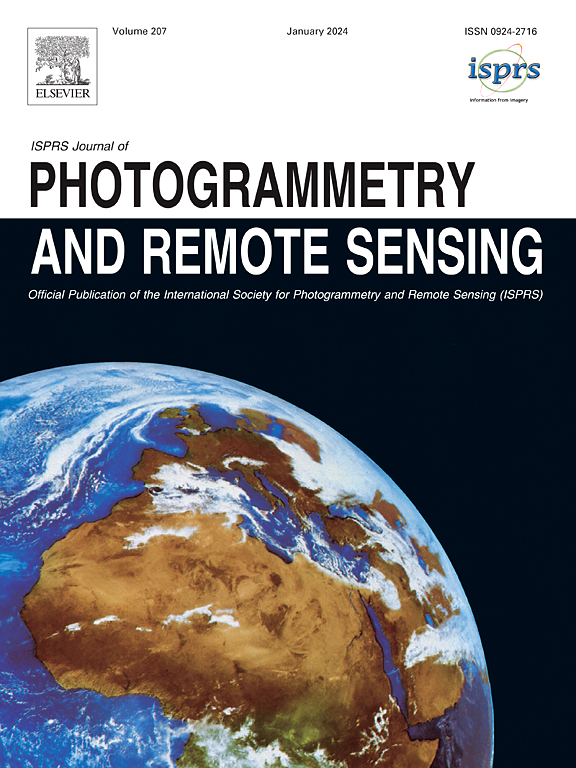基于小足迹机载激光雷达点云的异质森林精确星载波形模拟
IF 12.2
1区 地球科学
Q1 GEOGRAPHY, PHYSICAL
ISPRS Journal of Photogrammetry and Remote Sensing
Pub Date : 2025-02-01
DOI:10.1016/j.isprsjprs.2024.11.020
引用次数: 0
摘要
星载光探测和测距(LiDAR)波形传感器需要精确的信号模拟,以促进发射前校准、发射后验证和陆地表面数据产品的开发。然而,准确模拟非均匀森林上的星载LiDAR波形仍然具有挑战性,因为数据驱动的方法不能考虑非均匀冠层内复杂的脉冲传输,而分析辐射传输模型过度依赖于对冠层结构和分布的假设。因此,需要一种综合的模拟方法来考虑脉冲在冠层内传输的复杂性和森林结构的异质性。在这项研究中,我们提出了一个星载激光雷达波形模拟框架,该框架将一种新的辐射传输模型-冠层体素辐射传输(CVRT)模型-与小足迹机载激光雷达(ALS)点云重建的三维(3D)体素森林场景相结合。CVRT模型描述了冠层体素内的辐射传输过程,并使用分数冠层覆盖度来解释体素内的异质性,从而最大限度地减少了对冠层形状和分布的假设需求,并显著减少了输入参数的数量。场景构建和模型输入的所有参数都可以从ALS点云中获得。通过与DART的模拟激光雷达波形、全球生态系统动力学调查(GEDI)数据以及国家生态观测站网络(NEON)的土地、植被和冰传感器(LVIS)数据进行比较,评估了该框架的性能。结果表明,与现有模型相比,CVRT模型的新框架与模拟和测量数据的一致性得到了改善,平均R2提高了约2%至5%,平均RMSE降低了约0.5%至3%。所提出的框架对模型配置、输入数据质量和环境属性的变化也具有高度的适应性和鲁棒性。总之,这项工作扩展了目前在异质森林冠层上精确和强大的大足迹激光雷达波形模拟的研究,并有助于改进新兴星载激光雷达任务的产品开发。本文章由计算机程序翻译,如有差异,请以英文原文为准。
Accurate spaceborne waveform simulation in heterogeneous forests using small-footprint airborne LiDAR point clouds
Spaceborne light detection and ranging (LiDAR) waveform sensors require accurate signal simulations to facilitate prelaunch calibration, postlaunch validation, and the development of land surface data products. However, accurately simulating spaceborne LiDAR waveforms over heterogeneous forests remains challenging because data-driven methods do not account for complicated pulse transport within heterogeneous canopies, whereas analytical radiative transfer models overly rely on assumptions about canopy structure and distribution. Thus, a comprehensive simulation method is needed to account for both the complexity of pulse transport within canopies and the structural heterogeneity of forests. In this study, we propose a framework for spaceborne LiDAR waveform simulation by integrating a new radiative transfer model – the canopy voxel radiative transfer (CVRT) model – with reconstructed three-dimensional (3D) voxel forest scenes from small-footprint airborne LiDAR (ALS) point clouds. The CVRT model describes the radiative transfer process within canopy voxels and uses fractional crown cover to account for within-voxel heterogeneity, minimizing the need for assumptions about canopy shape and distribution and significantly reducing the number of input parameters. All the parameters for scene construction and model inputs can be obtained from the ALS point clouds. The performance of the proposed framework was assessed by comparing the results to the simulated LiDAR waveforms from DART, Global Ecosystem Dynamics Investigation (GEDI) data over heterogeneous forest stands, and Land, Vegetation, and Ice Sensor (LVIS) data from the National Ecological Observatory Network (NEON) site. The results suggest that compared with existing models, the new framework with the CVRT model achieved improved agreement with both simulated and measured data, with an average R2 improvement of approximately 2% to 5% and an average RMSE reduction of approximately 0.5% to 3%. The proposed framework was also highly adaptive and robust to variations in model configurations, input data quality, and environmental attributes. In summary, this work extends current research on accurate and robust large-footprint LiDAR waveform simulations over heterogeneous forest canopies and could help refine product development for emerging spaceborne LiDAR missions.
求助全文
通过发布文献求助,成功后即可免费获取论文全文。
去求助
来源期刊

ISPRS Journal of Photogrammetry and Remote Sensing
工程技术-成像科学与照相技术
CiteScore
21.00
自引率
6.30%
发文量
273
审稿时长
40 days
期刊介绍:
The ISPRS Journal of Photogrammetry and Remote Sensing (P&RS) serves as the official journal of the International Society for Photogrammetry and Remote Sensing (ISPRS). It acts as a platform for scientists and professionals worldwide who are involved in various disciplines that utilize photogrammetry, remote sensing, spatial information systems, computer vision, and related fields. The journal aims to facilitate communication and dissemination of advancements in these disciplines, while also acting as a comprehensive source of reference and archive.
P&RS endeavors to publish high-quality, peer-reviewed research papers that are preferably original and have not been published before. These papers can cover scientific/research, technological development, or application/practical aspects. Additionally, the journal welcomes papers that are based on presentations from ISPRS meetings, as long as they are considered significant contributions to the aforementioned fields.
In particular, P&RS encourages the submission of papers that are of broad scientific interest, showcase innovative applications (especially in emerging fields), have an interdisciplinary focus, discuss topics that have received limited attention in P&RS or related journals, or explore new directions in scientific or professional realms. It is preferred that theoretical papers include practical applications, while papers focusing on systems and applications should include a theoretical background.
 求助内容:
求助内容: 应助结果提醒方式:
应助结果提醒方式:


